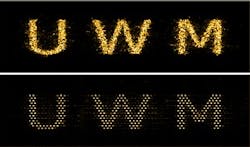Multimode optical fibers with 'Anderson localization' transmit high-quality images
Milwaukee, WI--Researchers from the University of Wisconsin-Milwaukee, Corning Inc. (Corning, NY; NYSE: GLE), and Clemson University (Clemson, SC) are using a phenomenon called Anderson localization to transmit bright, high-quality 2D images down optical fibers having a disordered dual-polymer structure.1
The fibers have a transversely disordered but longitudinally invariant structure, meaning that the disordered structure is 2D (always the same in any cross-section of the fiber).
Trapped spatial modes
Anderson localization can occur in an optical fiber with a strong scattering mechanism, resulting in the trapping of all spatial fiber modes in place laterally along the whole length of the fiber. The researchers found that the novel fiber architecture can transmit images with a quality that is comparable or better than the current commercial endoscopy imaging fiber bundles.
Because of this, the work has potential not only in next-generation high-speed communication, but also in biomedical imaging.
An image 30 microns wide was launched into the fiber. At the other end, a lens projected an enlarged image onto a screen. The optical fiber provided a direct one-to-one image transfer with less pixelation and higher contrast than the conventional imaging fiber bundle, says Arash Mafi, a researcher at the University of Wisconsin-Milwaukee.
The next step is to optimize the fiber itself. The researchers believe that image transport can be further improved by using a glass microstructured fiber with randomly distributed air holes of near-wavelength size and an air-hole fill fraction of 50%.
Source: http://www5.uwm.edu/news/2014/02/25/novel-optical-fibers-transmit-high-quality-images-2/
REFERENCE:
1. Salman Karbasi et al., Nature Communications (2014); doi:10.1038/ncomms4362

John Wallace | Senior Technical Editor (1998-2022)
John Wallace was with Laser Focus World for nearly 25 years, retiring in late June 2022. He obtained a bachelor's degree in mechanical engineering and physics at Rutgers University and a master's in optical engineering at the University of Rochester. Before becoming an editor, John worked as an engineer at RCA, Exxon, Eastman Kodak, and GCA Corporation.
